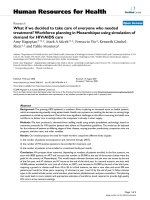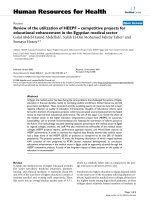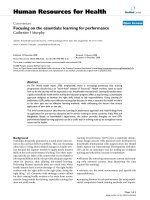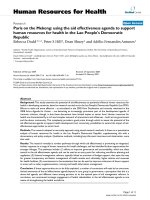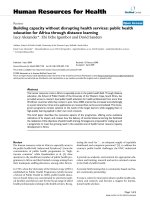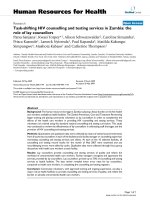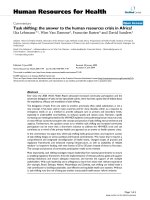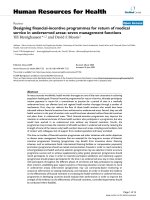báo cáo sinh học:" Task shifting: the answer to the human resources crisis in Africa?" pptx
Bạn đang xem bản rút gọn của tài liệu. Xem và tải ngay bản đầy đủ của tài liệu tại đây (214.53 KB, 4 trang )
BioMed Central
Page 1 of 4
(page number not for citation purposes)
Human Resources for Health
Open Access
Commentary
Task shifting: the answer to the human resources crisis in Africa?
Uta Lehmann*
1
, Wim Van Damme
2
, Francoise Barten
3
and David Sanders
1
Address:
1
School of Public Health, University of the Western Cape, Bellville, South Africa,
2
Department of Public Health, Institute of Tropical
Medicine, Antwerp, Belgium and
3
International Health, Department of Primary Care and Community Care, Radboud University Nijmegen, the
Netherlands
Email: Uta Lehmann* - ; Wim Van Damme - ; Francoise Barten - ;
David Sanders -
* Corresponding author
Abstract
Ever since the 2006 World Health Report advocated increased community participation and the
systematic delegation of tasks to less-specialized cadres, there has been a great deal of debate about
the expediency, efficacy and modalities of task shifting.
The delegation of tasks from one cadre to another, previously often called substitution, is not a
new concept. It has been used in many countries and for many decades, either as a response to
emergency needs or as a method to provide adequate care at primary and secondary levels,
especially in understaffed rural facilities, to enhance quality and reduce costs. However, rapidly
increasing care needs generated by the HIV/AIDS epidemic and accelerating human resource crises
in many African countries have given the concept and practice of task shifting new prominence and
urgency. Furthermore, the question arises as to whether task shifting and increased community
participation can be more than a short-term solution to address the HIV/AIDS crisis and can
contribute to a revival of the primary health care approach as an answer to health systems crises.
In this commentary we argue that, while task shifting holds great promise, any long-term success
of task shifting hinges on serious political and financial commitments. We reason that it requires a
comprehensive and integrated reconfiguration of health teams, changed scopes of practice and
regulatory frameworks and enhanced training infrastructure, as well as availability of reliable
medium- to long-term funding, with time frames of 20 to 30 years instead of three to five years.
The concept and practice of community participation needs to be revisited.
Most importantly, task shifting strategies require leadership from national governments to ensure
an enabling regulatory framework; drive the implementation of relevant policies; guide and support
training institutions and ensure adequate resources; and harness the support of the multiple
stakeholders. With such leadership and a willingness to learn from those with relevant experience
(for example, Brazil, Ethiopia, Malawi, Mozambique and Zambia), task shifting can indeed make a
vital contribution to building sustainable, cost-effective and equitable health care systems. Without
it, task shifting runs the risk of being yet another unsuccessful health sector reform initiative.
Published: 21 June 2009
Human Resources for Health 2009, 7:49 doi:10.1186/1478-4491-7-49
Received: 30 January 2008
Accepted: 21 June 2009
This article is available from: />© 2009 Lehmann et al; licensee BioMed Central Ltd.
This is an Open Access article distributed under the terms of the Creative Commons Attribution License ( />),
which permits unrestricted use, distribution, and reproduction in any medium, provided the original work is properly cited.
Human Resources for Health 2009, 7:49 />Page 2 of 4
(page number not for citation purposes)
Introduction
Ever since the 2006 World Health Report advocated the sys-
tematic delegation of tasks to less-specialized cadres and
"placing strong emphasis on patient self-management
and community involvement" [1], there has been a great
deal of debate about the expediency, efficacy and modali-
ties of task shifting.
The delegation of tasks from one cadre to another, previ-
ously often called substitution [2], is not a new concept. It
has been used in many countries and for many decades,
either as a response to emergency needs or as a method to
provide adequate care at primary and secondary levels,
especially in understaffed rural and urban facilities, to
enhance quality and reduce costs [3]. However, rapidly
increasing care needs generated by the HIV/AIDS epi-
demic and accelerating human resource crises in many
African countries, often within a context of near-collapse
of public health systems and increasing health inequali-
ties within and between countries, have given the concept
and practice of task shifting new prominence and urgency.
For example, it is estimated that sub-Saharan African
countries will have to triple their current health workforce
in order to come close to reaching the Health Millennium
Development Goals [4].
But while the above factors have lent urgency to task shift-
ing debates, particularly in many southern African coun-
tries, the question arises as to whether task shifting and
increased community participation can be more than a
short-term solution to address the HIV/AIDS crisis and
can contribute to a revival of the primary health care
approach as an answer to health systems crises [5].
Discussion
Reviews of evidence consistently show that delegation of
tasks, whether from doctors to non-physician clinicians,
including nurses [2,6-14], from nurses to nursing assist-
ants or aides or to non-professional or lay health workers
and patients [14-17] can lead to improvements in access,
coverage and quality of health services at comparable or
lower cost than traditional delivery models [2,18].
The literature is also unanimous, however, that any long-
term success of task shifting hinges on serious political
and financial commitments. Task shifting requires careful
attention to organization, structure and resourcing of
health services. Samb et al. argued, in the context of HIV/
AIDS services, that task shifting "must be aligned with the
broader strengthening of the health system if it is to prove
sustainable". They called on governments and interna-
tional and bilateral agencies to help prepare health sys-
tems to successfully implement task shifting by ensuring
the establishment of appropriate regulatory frameworks
and the building of training and management capacity
[3]. Given the comparably poor record of initiatives to
strengthen health systems and to enhance capacity in
many African countries, the question has to be asked:
What does this mean?
Crucially, it requires the integration of the concept and
roles of new cadres, changed scopes of practice and regu-
latory frameworks, enhanced training infrastructure, etc.,
into the mainstream health system, and a systematic
engagement with all the consequences. The delegation of
voluntary counselling and testing to lay health workers,
for example, may require not only the recruitment and
training of lay health workers, but also changes to the
roles, skills and workloads of nurses who have to coordi-
nate and supervise them [19].
Ultimately, successful task shifting requires a comprehen-
sive and integrated reconfiguration of health teams, par-
ticularly at community and primary care levels. Without a
health team approach, the introduction of new cadres or
delegation of tasks will invariably remain a fragmented
and unsustainable "add-on".
An example of a large-scale reconfiguration of health
teams is the "family health teams" created in Brazil in the
early 1990s. These teams, under the Programa de Sáude da
Família, usually are composed of at least one physician,
one nurse, a nurse assistant and (usually) four or more
community health workers who take responsibility for
providing a broad range of primary health care services in
an assigned geographical area [20]. It is worthwhile not-
ing that this programme is a central component of a
broader and well-funded new health policy and is embed-
ded within a comprehensive approach at area level that
also involves community-based organizations in deci-
sion-making about allocation of resources and in actions
that address some upstream determinants of health at the
local level.
Furthermore, the introduction and/or integration of new
cadres and community members into health care delivery
requires the availability of reliable medium- to long-term
funding, with time frames of 20 to 30 years instead of
three to five years [21]. Not only remuneration, but fund-
ing for training, supervision and infrastructure support
must be ensured. This becomes particularly challenging
when the targets for these initiatives are often remote,
hard-to-reach and notoriously underresourced areas in
countries with fiscal crises.
The concept and practice of community participation as
an important ingredient of task shifting, particularly with
regard to community health workers, needs to be revis-
ited. While the importance and benefit of community
involvement has long been acknowledged, it is neverthe-
Human Resources for Health 2009, 7:49 />Page 3 of 4
(page number not for citation purposes)
less widely recognized that a considerable gulf exists
between the ideal of programmes driven and owned by
communities and programme realities. It is further agreed
that while there are few success stories of lasting commu-
nity participation, sustainability and impact of pro-
grammes require the ownership and active participation
of communities as a non-negotiable precondition [22-
27].
If community involvement is to move from rhetoric to
reality and from specific, often fragmented, initiatives to
everyday practice, certain key issues need to be addressed.
Findings from research highlight "the importance of com-
mitment, the need to be clear about the levels and extent
of participation, and the importance of resolving matters
of representation" [28].
Involving lay health workers or community health work-
ers in health care delivery can enhance community partic-
ipation considerably, if these nonprofessional workers are
genuine representatives of their communities and give
these communities voice within health systems. Many
authors have indicated that these dimensions are central
to any discussion of participatory processes whatever the
context – although some contexts are more favourable
than others for genuine participation [29] – and that some
degree of clarity is called for when facilitating community
involvement [22,30-32].
Lastly, and probably most importantly, any serious com-
mitment to task shifting requires leadership from national
governments. It is national government's role to ensure an
enabling regulatory framework and credentialing system,
to drive the implementation of relevant policies and to
resource, guide and support training institutions to not
only upgrade training but also ensure appropriate initial
and continuing education (integrated, multidisciplinary,
community- and outcomes-based).
Crucially, the national government must harness the sup-
port of the multiple stakeholders who affect and are
affected by the reconfiguration of tasks (such as profes-
sional bodies and associations; trade unions; ministries of
health, education, finance and public service; nongovern-
mental and community organizations; and local health
structures) [33]. Where this is not the case, task shifting
will exist on the political and organizational periphery of
the formal health system, exposed to policy and funding
fashions, and become fragile and unsustainable.
In this context, it is noteworthy that in several countries,
task shifting has been enthusiastically taken up by NGOs,
with strong community links at the local level, but with
limited potential for national scaling-up, as their presence
is often geographically circumscribed and may often be
temporary, depending often on external, short-term
donor funding.
Task shifting, while driven by the urgencies of conquering
the HIV/AIDS epidemic, holds the potential of enabling
countries to build sustainable, cost-effective and equitable
health care systems, thus moving closer not only to the
Millennium Development Goals, but also the elusive
Health for All goal. However, the challenge of achieving
success cannot be underestimated. It requires a willing-
ness to learn from those with relevant experience (such as
Brazil, Ethiopia, Malawi, Mozambique and Zambia) and
to suspend conventional (and often conservative) wis-
dom on what can and cannot be done in favour of creativ-
ity and problem-solving.
Competing interests
The authors declare that they have no competing interests.
Authors' contributions
All authors jointly conceived of the article. UL had pri-
mary responsibility for the initial draft of the manuscript.
UL, WVD, FB and DS all contributed substantially to the
intellectual content, writing and finalization of the manu-
script. All authors read and approved the final manu-
script.
References
1. WHO: The world health report 2006: working together for health Geneva:
World Health Organzation; 2006.
2. Dovlo D: Using mid-level cadres as substitutes for interna-
tionally mobile health professionals in Africa. A desk review.
Hum Resour Health 2004, 2(1):7.
3. Samb B, Celletti F, Holloway J, Van Damme W, De Cock KM, Dybul
M: Rapid expansion of the health workforce in response to
the HIV epidemic. N Engl J Med 2007, 357(24):2510-2514.
4. JLI: Human resources for health. Overcoming the crisis Global health Ini-
tiative/Harvard University Press; 2004.
5. De Maeseneer J, Willems S, De Sutter A, Geuchte I Van de, Billings
M: Primary health care as a strategy for achieving equitable
care: a literature review commissioned by the Health Sys-
tems Knowledge Network of CSDH. 2007.
6. Huicho L, Scherpbier RW, Nkowane AM, Victora CG: How much
does quality of child care vary between health workers with
differing durations of training? An observational multicoun-
try study. Lancet 2008, 372(9642):910-916.
7. Morris AL, Phillips RL, Fryer GE Jr, Green LA, Mullan F: Interna-
tional medical graduates in family medicine in the United
States of America: an exploration of professional character-
istics and attitudes. Hum Resour Health 2006, 4:17.
8. Kruk ME, Pereira C, Vaz F, Bergstrom S, Galea S: Economic evalu-
ation of surgically trained assistant medical officers in per-
forming major obstetric surgery in Mozambique. Bjog 2007,
114(10):1253-1260.
9. Chilopora G, Pereira C, Kamwendo F, Chimbiri A, Malunga E, Berg-
strom S: Postoperative outcome of caesarean sections and
other major emergency obstetric surgery by clinical officers
and medical officers in Malawi. Hum Resour Health 2007, 5:17.
10. Libamba E, Makombe SD, Harries AD, Schouten EJ, Yu JK, Pasulani O,
Mhango E, Aberle-Grasse J, Hochgesang M, Limbambala E, et al.:
Malawi's contribution to "3 by 5": achievements and chal-
lenges. Bull World Health Organ 2007, 85(2):156-160.
11. Cumbi A, Pereira C, Malalane R, Vaz F, McCord C, Bacci A, Berg-
strom S: Major surgery delegation to mid-level health practi-
tioners in Mozambique: health professionals' perceptions.
Hum Resour Health
2007, 5(1):27.
Publish with Bio Med Central and every
scientist can read your work free of charge
"BioMed Central will be the most significant development for
disseminating the results of biomedical research in our lifetime."
Sir Paul Nurse, Cancer Research UK
Your research papers will be:
available free of charge to the entire biomedical community
peer reviewed and published immediately upon acceptance
cited in PubMed and archived on PubMed Central
yours — you keep the copyright
Submit your manuscript here:
/>BioMedcentral
Human Resources for Health 2009, 7:49 />Page 4 of 4
(page number not for citation purposes)
12. McCourt W, Awases M: Addressing the human resources crisis:
a case study of the Namibian health service. Hum Resour Health
2007, 5:1.
13. Tache S, Chapman S: The expanding roles and occupational
characteristics of medical assistants: overview of an emerg-
ing field in allied health. J Allied Health 2006, 35(4):233-237.
14. Morris MB, Chapula BT, Chi BH, Mwango A, Chi HF, Mwanza J,
Manda H, Bolton C, Pankratz DS, Stringer JS, et al.: Use of task-shift-
ing to rapidly scale-up HIV treatment services: experiences
from Lusaka, Zambia. BMC Health Serv Res 2009, 9:5.
15. Haines A, Sanders D, Lehmann U, Rowe AK, Lawn JE, Jan S, Walker
DG, Bhutta Z: Achieving child survival goals: potential contri-
bution of community health workers. Lancet 2007,
369(9579):2121-2131.
16. Lehmann U, Sanders D: Community health workers: What do
we know about them? The state of the evidence on pro-
grammes, activities, costs and impact on health outcomes of
using community health workers. In Evidence and Information for
Policy Edited by: Health DoHRf. Geneva: World Health Organisation;
2007.
17. Lewin SA, Dick J, Pond P, Zwarenstein M, Aja G, van Wyk B, Bosch-
Capblanch X, Patrick M: Lay health workers in primary and
community health care. Cochrane Database Syst Rev
2005:CD004015.
18. Walker DG, Jan S: How do we determine whether community
health workers are cost-effective? Some core methodologi-
cal issues. J Community Health 2005, 30(3):221-229.
19. Marchal B, De Brouwere V, Kegels G: Viewpoint: HIV/AIDS and
the health workforce crisis: what are the next steps? Trop Med
Int Health 2005, 10(4):300-304.
20. Macinko J, Guanais FC, de Fatima M, de Souza M: Evaluation of the
impact of the Family Health Program on infant mortality in
Brazil, 1990–2002. J Epidemiol Community Health 2006,
60(1):13-19.
21. Campbell C, Gibbs A, Maimane S, Nair Y: Hearing community
voices: grassroots perceptions of an intervention to support
health volunteers in South Africa. Sahara J 2008, 5(4):162-177.
22. Cohen J, Uphoff N: Rural development. Participation: concepts and meas-
ures for project design, implementation and evaluation
New York: Rural
Development Comittee; 1977.
23. Rifkin SB: Paradigms lost: toward a new understanding of
community participation in health programmes. Acta Trop
1996, 61(2):79-92.
24. Mathews C, Walt H van der, Barron P: A shotgun marriage –
community health workers and government health services.
Qualitative evaluation of a community health worker
project in Khayelitsha. S Afr Med J 1994, 84(10):659-663.
25. Quillian JP: Community health workers and primary health
care in Honduras. J Am Acad Nurse Pract 1993, 5(5):219-225.
26. Bhattacharyya K, Winch P, LeBan K, Tien M: Community Health
Worker incentives and disincentives: how they affect moti-
vation, retention and sustainability. Arlington, Virginia: BASICS/
USAID; 2001.
27. Gilson L, Walt G, Heggenhougen K, Owuor-Omondi L, Perera M,
Ross D, Salazar L: National community health worker pro-
grams: how can they be strengthened? J Public Health Policy
1989, 10(4):518-532.
28. Fawcett B, South J: Community involvement and Primary Care
Trusts: The case for social entrepreneurship. Critical Public
Health 2005, 15(2):191-204.
29. Sanders D: The State and Democratisation in Primary Health
Care: Community Participation in Zimbabwe's village health
workers' programme. In The Community Health Worker Edited by:
Frankel S. Oxford University Press; 1992:178-219.
30. Bracht N, Tsouros A: Principles and strategies of effective par-
ticipation. Health Promotion International 1990, 5(3):199-208.
31. Barnes M: Researching public participation. Local Government
Studies 1999, 25(4):60-75.
32. Foster G: Community development and primary health care:
Their conceptual similarities. Medical Anthropology. 1982,
6:183-195.
33. McPake B, Mensah K: Task shifting in health care in resource-
poor countries. Lancet 2008, 372(9642):870-871.
